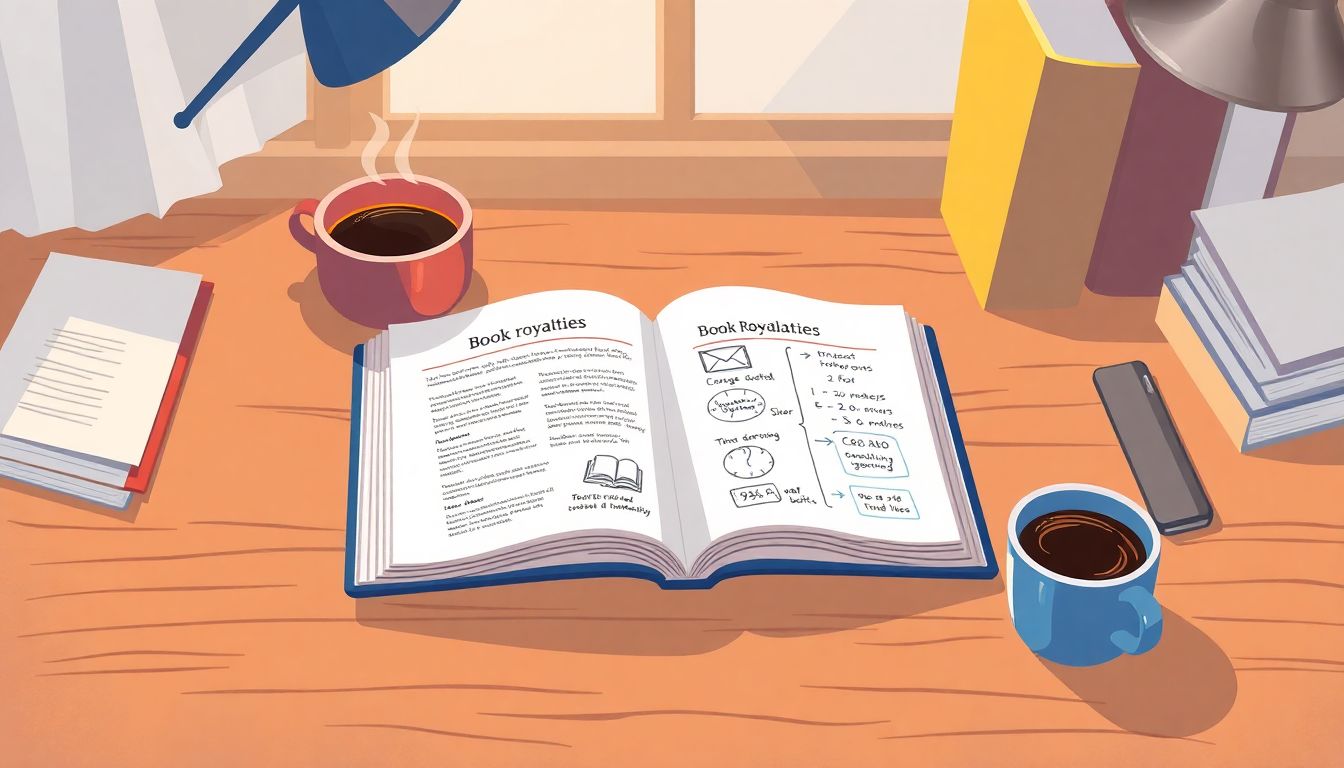Figuring out book royalties can feel confusing—like trying to split a restaurant bill among ten friends. If you’re scratching your head over terms like “net sales” or unsure about what royalty rate you actually deserve, don’t worry—you’re definitely not alone.
Stick around, and by the end of this guide, you’ll have a clear picture of how book royalties work. We’ll break each publishing method down into simple terms, help you spot the differences between royalty types, and even point you toward easy online tools to run your own numbers.
Ready to become a royalty calculating pro? Let’s jump in!
Key Takeaways
- Book royalties differ significantly between publishing methods. Traditional publishers generally offer around 8–12% royalties, while self-publishing options typically pay up to 70% for eBooks priced between $2.99 and $9.99.
- Traditional publishing royalties usually depend on net sales—the amount after retailer discounts and returns—rather than the book’s retail list price, lowering potential earnings per sale.
- Self-publishers receive higher royalties, but they handle all upfront costs and marketing. Amazon charges delivery fees for larger eBooks; Apple Books and Barnes & Noble Press don’t.
- Use free online royalty calculators from platforms like Amazon’s KDP or Draft2Digital to estimate earnings and choose pricing.
- Pick your publishing method according to your financial priorities—whether upfront advances from traditional publishers or higher earnings per sale through self-publishing.

Step 1: Understand Common Book Royalty Rates by Publishing Method
When you’re ready to publish your book, figuring out how royalties work is an essential first step.
Book royalties are basically the amount of money authors earn for each book sold, typically calculated as a percentage of sales.
But royalty rates can greatly differ depending on the publishing method you pick—either traditional publishing or self-publishing.
Traditional publishers generally offer book royalties around 7.5% to 15% for printed books, often landing closer to 8-12%.
On the other side, self-publishing royalties are way more generous, usually around 70% for eBooks priced between $2.99 and $9.99, and about 35% outside that range.
Let’s say you’ve got a paperback priced at around $5.95; on self-publishing platforms, you might snag a royalty of around 60%, earning roughly $3.57 per copy sold.
Keep in mind that these percentages aren’t set in stone—each publisher or platform has its specific rules, fees, and calculations.
For instance, platforms like Amazon’s KDP apply delivery fees, while others including Barnes & Noble Press and Apple Books generally offer a straightforward 70% rate without added fees.
So your best bet is to clearly understand which royalty method aligns best with your goals and circumstances.
Step 2: Learn How Traditional Publishing Royalties are Calculated
If you’re leaning toward a traditional publisher, you need to really dig into how royalties are calculated, because it’s not as simple as taking a percentage of the retail price printed on the back cover.
Most traditional publishers calculate royalties based on the book’s “net sales,” meaning the money left after discounts, returns, and other possible deductions are considered—not on the book’s list price.
For example, say your hardcover book has a list price of $25, but bookstores typically buy it at around a 50% discount ($12.50). Your royalty, say 10%, isn’t based on the $25 but rather on the $12.50—so you’d earn only $1.25 per sale.
There are also often escalations in traditional contracts, meaning your royalty percentage increases after you’ve sold a certain number of copies. For instance, you might start at 10% royalty rates for the first 5,000 copies sold, jumping up to 12% afterward.
Make it a point to thoroughly understand the royalty section in any contract before signing—it can make a huge difference to your earnings down the road.
Step 3: Know the Typical Self-Publishing Royalty Rates and Structures
If you’re thinking about self-publishing, royalty rates are way friendlier—but there’s a tradeoff. You’ll have more control, but also more responsibility in pricing, marketing, and distribution.
Amazon Kindle Direct Publishing (KDP) is a hugely popular option. They offer two main royalty tiers for eBooks: the 70% option and the 35% option. To get that 70% sweet spot, your eBook must be priced between $2.99 and $9.99, and you’ll cover any small delivery fees if your files are large (for instance, heavily illustrated books).
Outside that pricing range—say under $2.99 or over $9.99—your royalties drop down to 35%, with no delivery fee deducted.
Other platforms like Apple Books, Google Books, and Barnes & Noble Press usually offer around 70% royalties without any delivery fee deductions, making them attractive alternatives.
If you’re using an aggregator like Draft2Digital, remember they will take a percentage of your royalties as their fee, so do the math to see if it’s worthwhile.
Taking a moment to crunch the numbers and compare the different self-publishing platforms can save you from surprises and ensure you get the most bucks for your books. And who knows—you might end up making even more than you expected if you do your homework first!

Step 4: Recognize the Difference Between Royalties on Net Sales and List Price
This step is about clearing up a confusing but crucial difference—royalties calculated from net sales versus those based on the list price.
Simply put, royalties on list price mean you get a percentage of your book’s original selling price—straightforward and easy to track.
For example, if your paperback is listed at $16 and you get 10%, you’re easily earning $1.60 per book sold.
Royalties calculated on net sales get trickier because publishers base your earnings only on what’s left after retailers take their cut, discounts are subtracted, and returns factored in.
If your $16 book is sold at a 50% discount to bookstores, your royalty of 10% would be calculated off the reduced price ($8), leaving you just 80 cents per sale—a sizable difference from the original list price calculation.
It’s crucial to understand exactly what your publishing contract specifies, as traditional publishers usually base their royalties on net sales, and it can drastically reduce your expected earnings.
If you prefer the net sales method because it can lead to greater flexibility with discounts (which might boost overall sales volume), just know you’ll need to sell more copies to reach your ideal earnings.
A quick way to clarify the terminology in your publishing contract before signing it is reviewing this helpful breakdown on the difference between paperback and hardback.
Step 5: Calculate Your Potential Royalties Using Online Tools
Calculating potential royalties can sound complicated at first, but luckily there are some handy online tools available, making the math surprisingly simple.
Start by trying the free Amazon KDP Royalty Calculator, where you’ll insert your book format, retail price, royalty tier, and file size, and it quickly shows you how much money you’ll keep per sale.
If you’re publishing widely on platforms like Barnes & Noble Press or Apple Books, check out Draft2Digital’s built-in royalty estimation feature to better visualize what you’ll earn after aggregator fees.
Also, while figuring out price points that maximize your earnings, take into consideration average prices for similar books in your genre—charging too high or too low can both negatively affect your sales potential.
And don’t just think about eBooks—you can also calculate royalties from paperback or hardcover sales, audiobook sales, or other formats.
For instance, if you’re planning to publish a graphic novel, crunch the numbers using accurate guidelines on how to publish a graphic novel properly.
Doing a bit of pre-planning with tools beforehand not only helps avoid unexpected surprises down the line but can also highlight your profits clearly, helping you set attainable sales and earnings goals.
Step 6: Choose the Publishing Method Best Suited for Your Financial Goals
Finally, it’s decision time—you’ve understood royalties, calculated your potential earnings, but what publishing method will meet your financial expectations best?
Traditional publishing is appealing if you prefer upfront advances, professional editing provided at no cost, distribution channels, and marketing support. But remember, publishers typically offer royalty rates under 15%, usually between 7.5% to 12%.
Self-publishing provides significantly higher royalties (up to 70% with platforms like Amazon KDP), boosting earning potential greatly. However, there’s no advance and you’ll front costs for editing, formatting, design, and marketing yourself.
If you’re confident in your ability to promote yourself and manage those upfront expenses, self-pub is likely your best financial bet. Additionally, you can discover tips on selling eBooks on your own website, increasing your control over royalties.
On the flip side, if seeing your book stocked physically in bookstores nationwide or receiving a guaranteed advance matters more to you, traditional publishing may align better with your personal definition of financial success.
Take stock of your priorities: if maximizing per-sale earnings is crucial, self-publish and select smart strategies for pricing, promotions, and distribution.
If cash upfront and lower personal investment top your priority list, then targeting traditional publishing houses without an agent might also work well.
Ultimately, assessing clearly where your financial priorities lie and carefully considering these royalty pros and cons results in confident publishing decisions that feel right for both your wallet and your writing dreams.
FAQs
Traditional publishers usually offer royalty rates ranging between 5%-15% of the book’s retail price. Beginning authors often receive lower percentages, while established authors may negotiate higher royalty rates based on their prior sales records and overall recognition.
Self-publishing platforms can provide authors with royalty rates typically between 35%-70% on eBook and print sales, depending on pricing, formats, and online retailer requirements. Higher earnings per sale often compensate for relatively fewer total sales compared with traditional publishing.
Royalties based on net sales are calculated after deducting expenses or discounts from retail price, while royalties from list price are directly based on the book’s published cover price. Authors usually earn more per sale when royalties are based on list price.
Authors can estimate potential royalties using dedicated online royalty calculators provided by self-publishing platforms and online publishing resources. These tools allow authors to input pricing details, royalty percentages, and expected sales figures to determine potential earnings.
